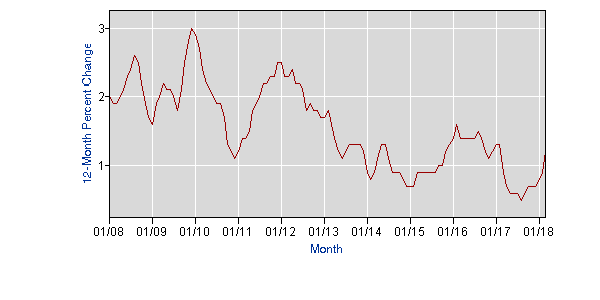December 20, 2016
The Federal Reserve Board raised interest rates last week and seem poised to do so again in the not distant future. The rationale is that the economy is now near or at full employment and that if job growth continues at its recent pace it will lead to a harmful acceleration in the inflation rate.
We have numerous pieces raising serious questions about whether the labor market is really at full employment, noting for example the sharp drop in employment rates (for all groups) from pre-recession levels and the high rate of involuntary part-time employment. But the story of accelerating inflation is also not right.
This is particularly important, since John Williams, the president of the San Francisco Federal Reserve Bank, cited accelerating inflation as a reason to support last week’s rate hike, and possibly future rate hikes, in an interview in the New York Times this morning. Williams has been a moderate on inflation, so there are many members of the Fed’s Open Market Committee who are more anxious to raise rates than him.
A close look at the data does not provide much evidence of accelerating inflation. The core PCE deflator, the Fed’s main measure of inflation, has risen 1.7 percent over the last year, which is still under the 2.0 percent target. This target is an average, which means that the Fed should be prepared to allow the inflation rate to rise somewhat above 2.0 percent, with the idea that inflation will drop in the next recession.
Anyhow, the 1.7 percent rate is slightly higher than a low of 1.3 percent reached in the third quarter of 2015, but it is exactly the same as the rate we saw in the third quarter of 2014. In other words, there has been zero acceleration in the rate of inflation over the last two years.
Furthermore, even this modest acceleration has been entirely due to the more rapid increase in rent over the last two years. The inflation rate in the core consumer price index, stripped of its shelter component, actually has been falling slightly over the last year. It now stands at 1.1 percent over the last year.
Core CPI, Minus Shelter

Source: Bureau of Labor Statistics.
It is reasonable to pull shelter out of the CPI because rents do not follow the same dynamic as most goods and services. In fact, higher interest rates, by reducing construction, are likely to increase the pace of increase in rents rather than reduce them.
This issue is hugely important, since if the Fed prevents the labor market from tightening further, it will be preventing millions of people from getting jobs. These people are disproportionately African American and Hispanic and also less-educated workers. The decision to tighten will also lessen the bargaining power of a much larger group of workers, making it more difficult for them to get pay increases.
The weak labor market of the Great Recession resulted in a large redistribution from wages to profits. The tightening of the labor market in the last two years has reversed part of this shift. If the Fed raises interest rates enough to prevent further tightening, then it will be locking in place this redistribution to profits. That would be bad news for tens of millions of workers, especially if the decision was based on a misreading of inflation data.







Comments